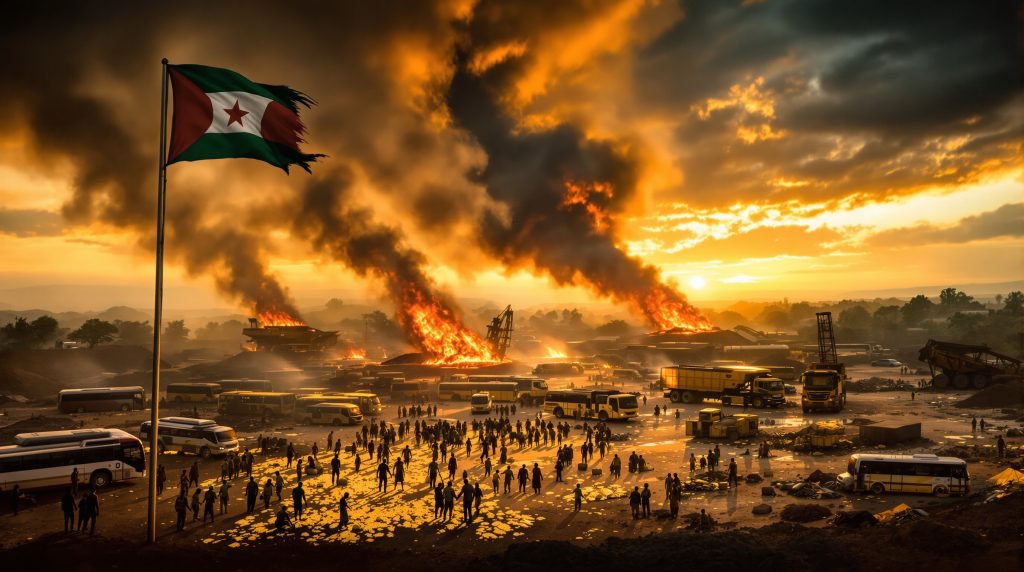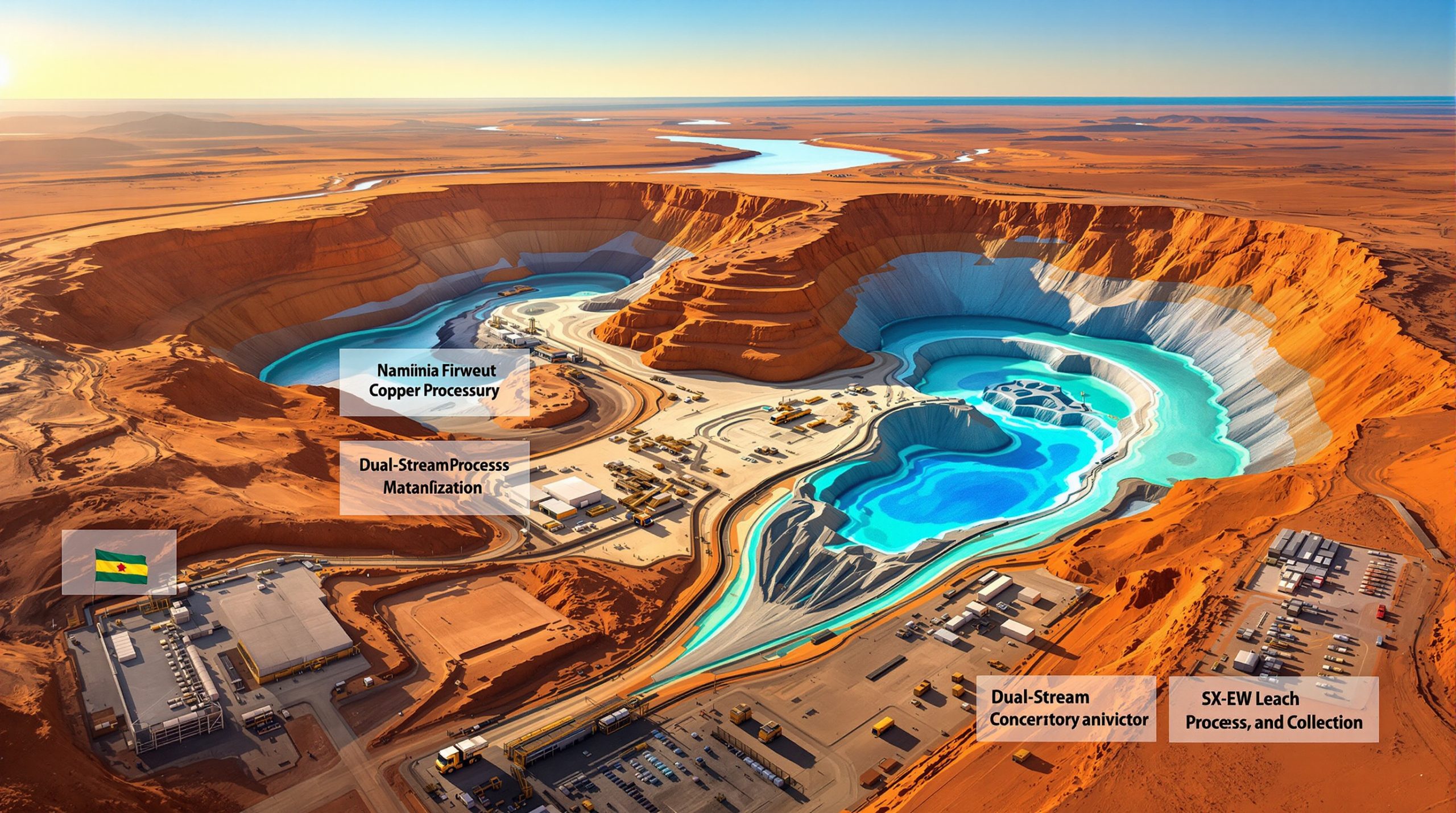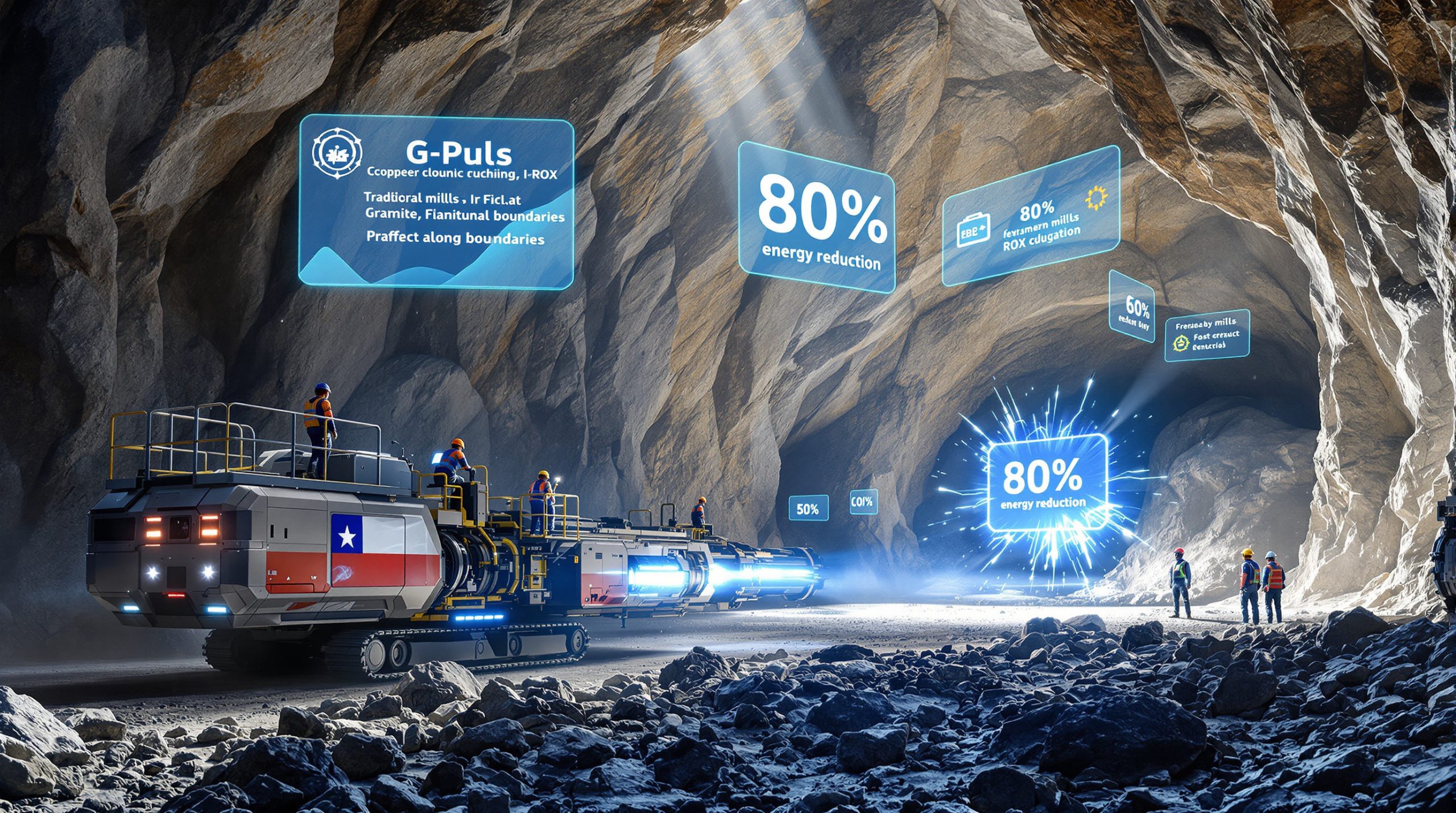What Led to the Deadly Riot at Guinea's Gold Mine?
The recent violence at Weily Mining's Niagassola site in Guinea's northeastern Siguiri region has resulted in serious criminal charges against 60 individuals. This unrest erupted on October 4 when local protesters demanded the release of 17 people previously detained over vandalism incidents at the same mining operation. What began as a protest escalated dramatically, resulting in extensive property damage and loss of life.
During the riot, protesters stormed the mining facility, setting fire to multiple vehicles and buildings. The destruction was substantial, with 10 buses completely destroyed by fire, 2 pickup trucks burned (including one belonging to security forces), 2 buildings set ablaze, 2 people killed in the violence, and multiple injuries reported among those involved.
Prosecutors have filed multiple Guinea gold mine riot charges against those arrested, including voluntary arson, destruction of property, and complicity in murder. The incident represents a significant escalation in tensions between local communities and mining operations in this resource-rich region, highlighting the complex social dynamics at play in Guinea's extractive sector.
How Does This Incident Reflect Guinea's Broader Mining Challenges?
The Siguiri region represents a microcosm of Guinea's complex mining landscape. As one of Africa's premier gold-producing areas, it hosts both large-scale industrial operations and widespread artisanal mining activities. AngloGold Ashanti maintains multiple open-pit gold mines in the region, while Weily Mining only recently began gold exports from its Niagassola operation in September 2024.
This latest violence exemplifies the tensions that have been building across Guinea's mining sector since the military junta took power in 2021. The current administration has implemented aggressive policies aimed at restructuring the country's approach to natural resource management, focusing on:
- Renegotiating existing mining contracts to increase state revenue
- Accelerating development of new mining projects
- Enhancing government control over natural resource extraction
- Cracking down on illegal mining operations
These policies, while potentially beneficial for national economic development, have created significant friction with local communities who often feel excluded from the benefits of resource extraction on their traditional lands. The Weily Mining riot illustrates how quickly these underlying tensions can erupt into violence when specific grievances trigger broader expressions of dissatisfaction.
What Makes Guinea's Natural Resources So Strategically Important?
Guinea possesses extraordinary mineral wealth that extends far beyond its gold reserves, making it a critical player in global resource markets. The country's strategic importance is illustrated by its reserves in key minerals:
| Resource | Global Significance |
|---|---|
| Bauxite | World's largest reserves (approximately 7.4 billion metric tons) |
| Iron Ore | Massive high-grade deposits at Simandou (over 2 billion tonnes) |
| Gold | Major production in Siguiri region (50-60 tonnes annually) |
| Other Minerals | Significant diamond and base metal potential |
The country's bauxite reserves are particularly crucial to global aluminum production, with Guinea serving as a major supplier to international markets including China, which has become increasingly dependent on Guinean bauxite imports. This has led to substantial Chinese investment in Guinea's mining sector, with companies establishing significant mining and processing operations throughout the country.
The Simandou iron ore project represents one of the world's largest undeveloped high-grade iron ore resources. The deposits are notable not just for their size but for their exceptional iron content, which exceeds 65% in many areas, making them among the highest-grade iron ore deposits globally. This quality makes the resource particularly valuable for steelmaking, but developing it requires massive infrastructure investments, including a 650-kilometer railway and port facilities.
This extraordinary mineral wealth has attracted international mining companies but also created complex dynamics between foreign investors, the national government, and local communities that struggle to see tangible benefits from resource extraction.
How Are Authorities Responding to the Mining Unrest?
Following the deadly riot, Guinea's authorities have taken decisive legal action. Siguiri's public prosecutor, Ibrahima I. Camara, issued a formal statement outlining the charges against those arrested and explaining the next steps in the legal process. The government has announced a comprehensive response that includes:
- Joint investigations conducted by both police and gendarmerie to ensure thorough evidence collection
- Serious criminal charges against the 60 individuals, including murder, which carry significant penalties
- A demonstrated commitment to maintaining security at mining sites across the country
- Legal proceedings according to established protocols within Guinea's justice system
This response reflects the government's determination to protect mining assets while addressing criminal behavior. The involvement of both police and gendarmerie in investigations indicates a coordinated security approach that brings together different law enforcement capabilities to handle what authorities clearly view as a serious threat to the country's economic interests.
However, the focus on punishment rather than addressing underlying community grievances raises questions about whether this approach will prevent future conflicts or merely suppress symptoms of deeper problems. The legal response, while necessary from a security perspective, does not appear to include substantial measures to address the social and economic factors that contributed to the unrest.
What Factors Are Driving Community-Mining Tensions in Guinea?
Several interconnected factors contribute to the recurring conflicts between mining operations and local communities in Guinea's gold-producing regions, creating a complex web of grievances and structural challenges:
Economic Disparities
Many communities near mining operations perceive that they receive insufficient economic benefits from resource extraction on their traditional lands. While mining creates some employment, the distribution of wealth often appears inequitable to local residents, who see valuable resources extracted from their areas while they remain in poverty. This perception of inequity becomes particularly acute when mining companies are foreign-owned and profits flow out of the country.
Displacement of Artisanal Miners
The formalization and industrialization of mining frequently displaces artisanal miners who have traditionally worked in these areas. These small-scale miners often lack alternative livelihood options when industrial operations take over their traditional mining areas. Without compensation, alternative livelihood support, or employment opportunities in the industrial operation, these displaced miners face economic hardship that can fuel resentment and opposition to mining companies.
Environmental Concerns
Industrial mining creates significant environmental impacts, including water pollution from processing chemicals and mine waste, deforestation from mine development and access roads, soil degradation from heavy equipment and waste disposal, and air pollution from dust and processing operations. These effects directly impact agricultural communities that depend on natural resources for survival, potentially threatening food security and water availability for local populations.
Governance Challenges
Weak institutional frameworks for managing community relations, environmental impacts, and benefit-sharing arrangements contribute to ongoing tensions. When communities feel they lack effective channels for addressing grievances, protests and violence become more likely as desperate measures to gain attention and redress. The absence of transparent consultation processes, clear benefit-sharing mechanisms, and accessible dispute resolution forums leaves communities feeling powerless in the face of mining development.
How Does This Incident Compare to Previous Mining Conflicts?
The Weily Mining riot follows a pattern of similar incidents across Guinea's resource-rich regions. Mining-related conflicts have become increasingly common as the military government pursues its agenda of maximizing state revenue from natural resources.
Key similarities to previous incidents include:
- Protests triggered by perceived injustice (in this case, the detention of community members)
- Escalation from peaceful demonstration to property destruction
- Security force intervention resulting in casualties
- Mass arrests and criminal charges following the unrest
This recurring pattern suggests that underlying structural issues in Guinea's mining sector remain unresolved despite government efforts to assert greater control over resource extraction. The fact that similar incidents continue to occur indicates that the government's security-focused response, while potentially effective at punishing those involved in specific incidents, has not addressed the root causes that lead communities to protest against mining operations.
The escalation pattern—from grievance to protest to property destruction to security intervention to mass arrests—represents a cycle that could be interrupted at multiple points through more effective conflict prevention and resolution mechanisms. The failure to break this cycle suggests gaps in early warning systems, community engagement practices, grievance resolution mechanisms, and security protocols that might prevent escalation.
What Are the Implications for Guinea's Mining Investment Climate?
The violence at Weily Mining's operation raises concerns about security and stability in Guinea's mining sector. For international investors, such incidents highlight operational risks that must be factored into investment decisions.
Key implications include:
-
Increased Security Costs: Mining companies operating in Guinea may need to allocate additional resources to physical security measures such as fencing, guards, surveillance systems, and secure transportation, as well as community relations programs designed to build goodwill and address grievances before they escalate. These additional costs reduce project profitability and must be incorporated into investment calculations.
-
Regulatory Uncertainty: The junta's approach to mining regulation continues to evolve, creating challenges for long-term investment planning. Companies must navigate an environment where contract terms may be renegotiated, permitting processes might change, and government priorities could shift, adding complexity to project development and operation.
-
Reputational Risks: Companies operating in regions with community conflicts face increased scrutiny from shareholders, NGOs, and consumers concerned about ethical sourcing. Incidents like the Weily Mining riot can damage corporate reputations and potentially affect access to financing, particularly as ESG (Environmental, Social, and Governance) considerations become more important to investors.
-
Production Disruptions: Violence and unrest can lead to temporary mine closures, affecting production targets and financial performance. Even short-term disruptions can have significant impacts on project economics, particularly for smaller companies with limited financial reserves to weather periods of non-production.
Despite these challenges, Guinea's extraordinary mineral wealth continues to attract investment, particularly in the bauxite sector where the country's competitive advantage is most pronounced. Companies appear willing to accept elevated risk levels in exchange for access to Guinea's high-quality, abundant resources, though they may demand higher returns to compensate for these risks.
How Might Mining Companies Better Address Community Relations?
The recurring pattern of mining-related violence suggests that current approaches to community engagement may be insufficient. Mining companies operating in Guinea could consider several strategies to reduce conflict risk:
Transparent Benefit-Sharing Arrangements
Establishing clear, transparent mechanisms for sharing mining benefits with local communities can help address perceptions of inequity. These might include local procurement initiatives that prioritize purchasing from community businesses, community development funds that provide resources for infrastructure and social programs, or equity participation models that give communities a direct stake in mining operations.
Meaningful Consultation Processes
Engaging communities in genuine consultation before and during mining operations can help identify and address concerns before they escalate into conflict. This requires investment in professional community relations teams with appropriate cultural understanding and language skills, as well as commitment to incorporating community feedback into operational decisions.
Environmental Stewardship
Implementing robust environmental management systems and transparently communicating about environmental impacts can help build trust with communities concerned about pollution and resource degradation. This includes regular monitoring and reporting of water quality, air emissions, and land reclamation efforts, as well as involving community representatives in environmental monitoring activities.
Support for Alternative Livelihoods
Recognizing the displacement of artisanal miners and agricultural activities, companies can invest in programs that support alternative livelihood development in affected communities. These might include skills training for employment in the formal mining sector, support for agricultural improvement projects, or microfinance initiatives to help community members start small businesses.
These approaches require sustained commitment and investment, but they can significantly reduce conflict risk and create more stable operating environments. By treating communities as partners rather than obstacles, mining companies can build the social license to operate that is increasingly essential for successful resource development.
What's Next for the Legal Proceedings?
The 60 individuals charged in connection with the Weily Mining riot now face a complex legal process. Guinea's justice system will need to determine individual culpability while navigating the political sensitivities surrounding mining-related conflicts.
Key aspects of the upcoming legal process include:
-
Evidence Gathering: The joint police and gendarmerie investigation will collect witness testimonies and physical evidence to support the prosecution's case. This includes documenting property damage, identifying participants through witness accounts and possibly surveillance footage, and establishing the sequence of events that led to the deaths.
-
Judicial Proceedings: Accused individuals will move through Guinea's court system, potentially facing lengthy prison sentences if convicted of serious charges like murder. The proceedings may take considerable time given the number of defendants and complexity of the case.
-
Political Considerations: Given the strategic importance of mining to Guinea's economy, the government may view these proceedings as an opportunity to demonstrate its commitment to protecting investment. This could influence how vigorously cases are prosecuted and what penalties are sought.
-
International Scrutiny: Human rights organizations may monitor the proceedings to ensure due process is followed, particularly given Guinea's complex political situation under military rule. This external attention could affect how authorities manage the cases and what transparency is provided into the legal process.
The outcome of these proceedings will likely influence community-company relations across Guinea's mining sector in the coming years. A process perceived as fair and balanced could help restore stability, while one viewed as excessively harsh or politically motivated might further inflame tensions.
Conclusion: Balancing Economic Development and Community Rights
The deadly riot at Weily Mining's operation highlights the delicate balance Guinea must strike between leveraging its extraordinary mineral wealth for national development and addressing the legitimate concerns of communities affected by mining activities. As the country continues to attract investment in its gold market trends, bauxite, and iron ore sectors, developing more effective approaches to community engagement, benefit sharing, and conflict resolution will be essential.
For mining companies, the incident serves as a reminder that technical and financial feasibility alone are insufficient for successful operations in complex social environments. Investing in robust community relations, environmental management, and sustainable development initiatives is increasingly not just a matter of corporate social responsibility but a core business requirement for maintaining operational continuity.
As Guinea's military government pursues its agenda of maximizing returns from the country's natural resources, finding approaches that also address community needs and aspirations will be crucial for sustainable development of the mining sector. This will require a more inclusive vision of resource governance that recognizes the legitimate interests of all stakeholders—from international investors to local communities—in Guinea's mineral wealth.
The challenge for Guinea moving forward is to transform its extraordinary mineral endowment from a source of conflict into a foundation for shared prosperity. This will require not just legal enforcement and security measures, but also industry consolidation strategies and institutional reforms, transparent revenue management, equitable benefit-sharing mechanisms, and meaningful community participation in resource governance decisions.
Recent gold prices analysis suggests continued strong market conditions, which will likely intensify interest in Guinea's gold resources. However, without addressing the underlying social tensions, the gold market resurgence may bring as many challenges as opportunities for Guinea. Furthermore, industry experts emphasize that mineral exploration insights must be complemented by social research to ensure sustainable development of these resources.
Further Exploration
Readers interested in learning more about mining developments in Guinea can explore related educational content from Mining Weekly, which offers regular reporting on mining activities across Africa and other global regions.
Ready to Capitalise on the Next Major Mineral Discovery?
Stay ahead of significant ASX mineral announcements with Discovery Alert's proprietary Discovery IQ model, which transforms complex mineral data into actionable insights for investors of all experience levels. Explore our dedicated discoveries page to understand why major mineral discoveries can lead to exceptional market returns, and begin your 30-day free trial today.




